Breakdown of the Data Analyst Salary and Job Market

 Written by:
Written by:Nathan Rosidi
Who are data analysts and how high is their salary? What skills do you need to become one? You'll find the answers to these questions in this article.
The data analyst is one of the job positions belonging to a much wider family of data scientists. The name of this position is relatively self-explanatory: data analysts analyze data.
What this includes depends on the company where the data analyst works, but it rarely includes only analyzing data in the strictest sense.
A data analyst's job description goes beyond the data analysis itself. After all, they are data experts and will be handling the whole process of which analyzing data is only a part.
But what does that include?
What Does a Data Analyst Do?
The point of data analysis is to make informed business decisions.
Because of that, data analysis always starts with defining which decision you need to make. In other words, what is a business problem that has to be solved by using data analysis? Defining a business problem is done by the data analyst’s superiors or in consultation with the data analyst.
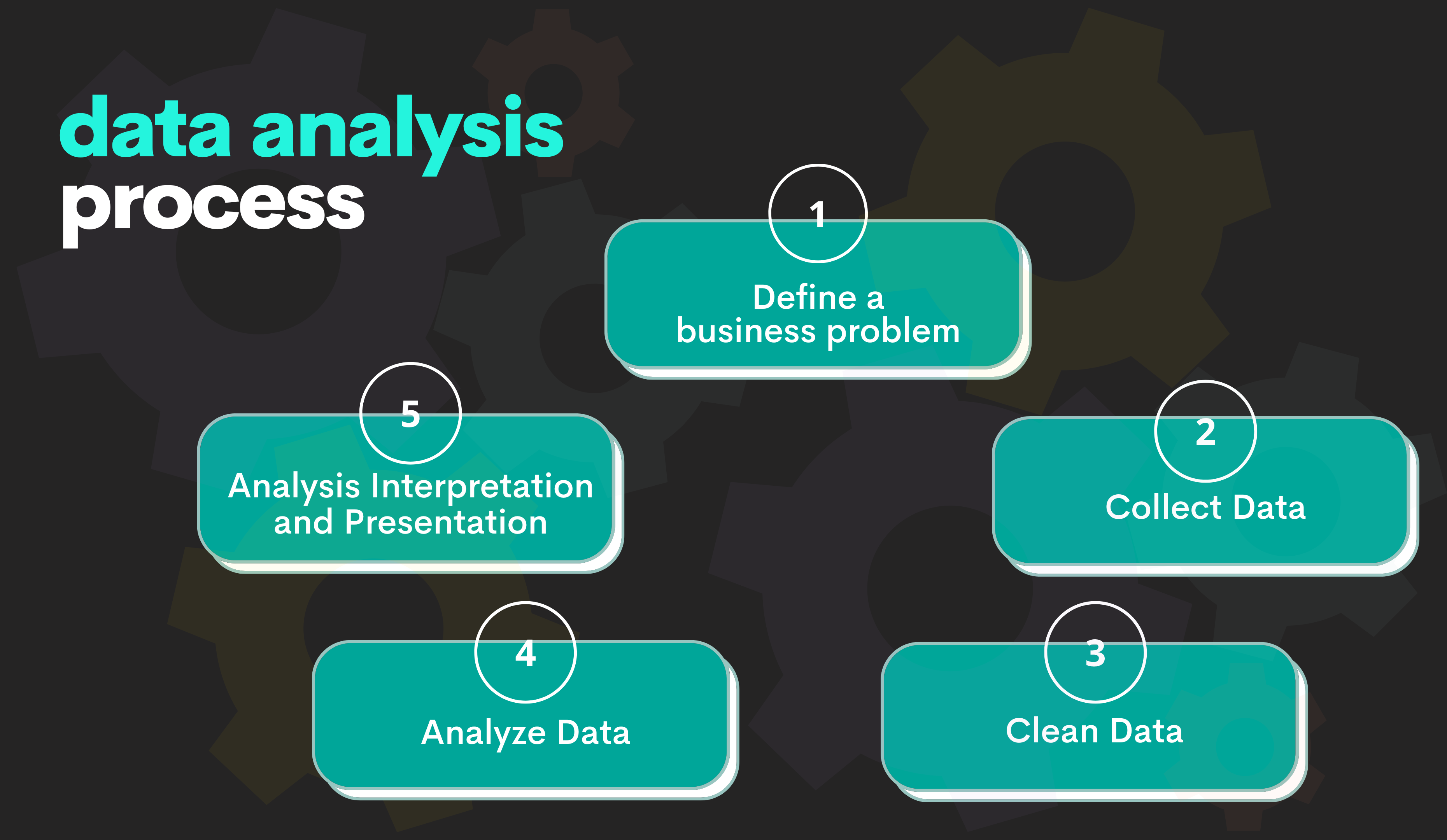
Next, a data analyst must identify which data they need and if it is available. If it is, they have to decide on which data sources they need and then collect the data.
Before analyzing it, data has to be cleaned, transformed, formatted, and, in general, prepared for data analysis. This is called data wrangling or data munging. Besides making data suitable for data analysis, its quality also has to be assured. There’s no point in making a great analysis of garbage data. Remember the GIGO principle: garbage in, garbage out
After the data is prepared, the data analyst finally analyzes it. To do that, they use different techniques or data analysis types which we’ll cover very soon.
The latest step in the data analysis process is analysis interpretation. In other words, a data analyst has to give business meaning to data analysis and present insights.
Types of Data Analysis
There are four most commonly used types of data analysis:
- Descriptive Data Analysis
- Diagnostic Data Analysis
- Predictive Data Analysis
- Prescriptive Data Analysis

1. Descriptive Data Analysis
Question: What happened?
How it answers it: In giving the answer, the descriptive analysis uses historical and current data to find trends in data. It does that by summarizing and comparing data. To find insights, data analysts will have to use standard statistical methods, such as mode, median, mean, variance, and standard deviation, or percentiles and quartiles.
2. Diagnostic Data Analysis
Question: Why it happened?
How it answers it: To answer the above question, the diagnostic data analysis uses the trends discovered by the descriptive analysis. It applies techniques such as drill-down and data mining to find the correlations within data. This type of analysis also relies on time-series and regression analysis, as well as probability.
3. Predictive Data Analysis
Question: What could happen?
How it answers it: Unlike the previous two types, this analysis looks into the future. By using it, the companies are trying not to wait for something to happen but to be aware of the possible outcomes in advance. To predict the outcome, this analysis uses techniques such as data mining, time series analysis, predictive modeling, logistic regression, and machine learning.
4. Prescriptive Data Analysis
Question: What to do?
How it answers it: It works with predictive analysis to recommend specific actions for the desired outcome or to avoid the undesired one. To achieve that, it uses graph analysis, data mining, data modeling, machine learning, artificial intelligence, and other advanced technologies.
What Are the Skills Required for a Data Analyst?
The skills you will need as a data analyst reflect the data analysis process in a broader sense and the type of analyses you will be using.
Data analysts mostly use descriptive and diagnostic data analysis. Because of that, they are generally not required to know machine learning. But depending on the company, predictive and prescriptive analysis can be required from data analysts. In other words, they will have to know ML. However, this is more an exception than a rule.
Based on the above, we’ve drawn out the main skills you need as a data analyst.
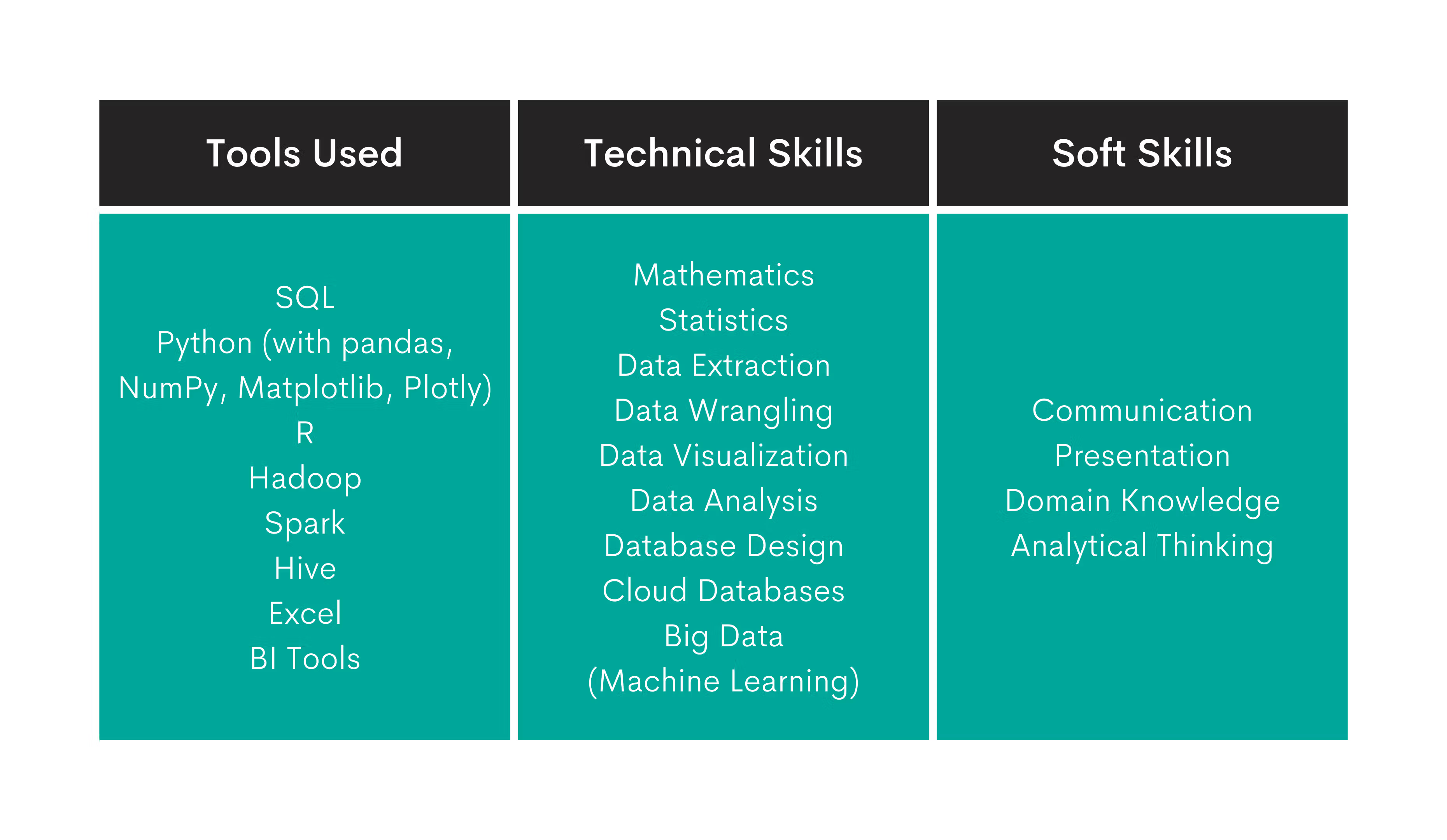
Tools used in data analysis, technical and soft skills required are all intertwined.
SQL is a programming language designed to communicate with relational databases, so it’s perfect for data extraction, wrangling, and analysis. Naturally, you’ll have to understand how the databases are designed and how they work to use SQL to the maximum extent.
Python does data extraction almost as well as SQL. However, its strength is data wrangling and data analysis, especially when used with libraries such as pandas and NumPy. You can also visualize data with it, and some of the libraries good for that are Matplotlib and Plotly. Python is an extremely powerful tool, and there is a reason why it’s one of the most popular programming languages in data analysis. But where it really shines is modeling and machine learning.
R is not as versatile as Python, and it’s not used for data extraction. It is designed for data analysis and visualization, which it does extremely well.
Knowing Hadoop, Spark, and Hive is a must when dealing with big data.
With big data storing such huge amounts of data becomes a problem. Due to that and other reasons (read: cost), more and more companies are moving their databases to the cloud. Requiring experience with cloud databases has become a more regular feature of data analyst job ads. When talking about the cloud, we think you should be familiar with at least Azure, Google BigQuery, or AWS.
Excel can also be a helpful tool for analyzing and visualizing data. Even though sometimes data analysts tend to look at it condescending, Excel is quite a powerful tool for data analysis, visualization, and presenting your insights. It’s especially good when you want to perform some quick data inspection or analysis and visualize it in a simple manner.
BI tools also allow you to perform data analysis, but they shine when it comes to presentation. The possibilities to create beautiful charts, dashboards, reports, and other visualizations are almost endless. This is one of the critical data analyst tools. What’s the point of doing a great data analysis and having earth-shattering insights if you can’t present them to others so they understand them?
Whatever tool you use, your mathematical and statistical skills, along with analytical thinking and problem solving, will be behind it. You saw from the data analysis types that the statistical knowledge you need includes a measure of frequency, measures of central tendency, measures of dispersion, measures of position, correlations, probability, regression analysis, and time-series analysis. In some rarer cases, it could also include logistic regression, predictive modeling, data modeling, ML, and AI.
Whatever you do will have a business purpose. All your technical knowledge will be in vain if you don’t know how to use it in a business context. For instance, if you’re a product analyst, you’ll have to be aware of the company’s and competitors’ products, market trends, industry specifics, and so on. No matter the data you analyze, knowing about the industry, the company itself, products, other business aspects, and how your work influences the company’s performance is a plus for every data analyst. That’s why it’s not that rare that data analysts start from the knowledge domain and then, with working experience, go more into data and data analysis.This also signals there is more than one right way to become a data analyst.
How to Become a Data Analyst
There are two main ways of becoming a data analyst. One is getting an academic education. The other one is acquiring knowledge outside the academy.
Academic Learning
The classic approach would be to earn a bachelor’s degree in mathematics, statistics, computer science, economics, or any relevant quantitative field.
This is usually a minimum requirement in most job ads around. If you have a master’s degree or a Ph.D. from a relevant field, then even better for you.
There’s a general opinion that it’s easier for someone skilled in data analysis to learn the industry specifics than for a domain expert to learn data analysis. While this might be the case, it’s far from impossible or rare to become a data analyst with a degree in a non-technical field. Especially if the domain knowledge is critical, e.g., in the pharmaceutical industry.
Non-Academic Learning
What if you don’t have a degree at all? Could you get in data analysis still? Yes! For two reasons, at least.
First, some big companies, such as Meta and Google, are not requiring a degree anymore and are assessing the applicants only through their job interview performance. It’s fair to expect that other companies could soon follow.
The other reason not having a degree isn’t that much of a problem is that there are vast non-academic educational material resources. You will need time and dedication to master data analysis this way. Well, it’s not that different from getting a degree.
The disadvantage is that academic education gives more structure to your learning. What about money? It’s true. Some non-academic learning resources require money; sometimes, it’s not a low amount. However, it’s still usually significantly cheaper than university tuition, with plenty of resources also being completely free.
One of the ways to become a data analyst is by attending a bootcamp. They are designed to equip you with all the necessary skills you will need when you start looking for data analyst jobs. There are in-person but also online bootcamps, and you can find some suggestions at CareerFoundry.
Then there are online courses, with Coursera and Udemy being the most popular resources. They are not popular without reason. Besides the sheer amount of courses they offer, there is also a vast amount of different topics covered: from learning about data analytics in general to acquiring specific skills such as SQL, Python, R, statistics, data modeling, etc.
If you want to concentrate on coding skills, there are plenty of SQL, Python, and R interactive courses, such as LearnSQL.com, Codecademy, or DataCamp.
Another good way is to practice your coding skills by solving the actual interview questions, such as those at StrataScratch or LeetCode.
Less interactive methods of learning data analyst skills are reading books and blogs or watching great instructional videos on Youtube.
If you can afford this, both time- and sometimes money-wise, combining several options would be ideal for increasing your chances of getting a data analyst job.
Speaking of jobs, let’s now look at the prospects of becoming a data analyst.
Is Data Analytics a Good Career?
We'll look at the aspects to decide whether data analytics is a good career option. One is the job prospects, and the second is how stressful a data analyst’s job is.
However, before you decide on getting into data analysis, we advise you to consider what you like, now only how much money you can earn. If digging through endless records of data, getting lost in it, occasionally feeling like an imposter (because you’re not able to find any meaningful insight), then suddenly realizing you’re actually a Director of Data Analysis Universe (you got insights and great ones!) sounds intriguing then data analysis could be a good choice for you.
Data Analytics Job Prospects
The U.S. Bureau Of Labor Statistics projects that operations research analysts' employment will rise 23% between 2021 and 2031, which is much faster than average.
Other similar job that includes data analysts is mathematicians and statisticians, who will have an even higher increase of 31%. Some other data analyst jobs with an employment increase higher than average are financial analysts and market research analysts.
According to the E&Y report, the number one investment priority for companies in 2022 is data and analytics, with 53% of companies identifying it as such. A significant increase compared to 35% of respondents in 202.
The same report indicates that 19% of respondents identified a talent shortage among the top three blockers to implementing data-centric management.
Also, Glassdoor lists Data Analyst as one of the 50 best jobs in the USA for 2022.
From this perspective, data analysis looks like a hot job! It is. A skeptic in you, however, asks if there is a downside to it. Yes, there is.
Is Data Analytics a Stressful Job?
If you apply the basic market rules, you could assume the high demand for data analysts means it’s a highly-paid job. (It is, which we will see later on.) You also know that employers won’t just throw that money at you. They want something back – your time.
In data analytics, the working hours can get late, especially if you’re a beginner. Having a lot to learn and needing to prove yourself will require more time at the start of your career.
On top of that, data analysis, in general, is usually tied to some business goal, which requires making a decision. This, in turn, means there’s a specific deadline for making that decision. It puts additional pressure on data analysts because their analysis has to be fast and accurate. (Some older data analysts would note that it’s either/or relationship – the analysis can be either fast or accurate. As you get more experience, you’ll be able to impose more of that philosophy on your superiors.)
Throw a shortage of data analysis talent into it, and you can be almost sure that there will be more workload on one data analyst than it should be.
All these factors combined can make data analysis a stressful job. However, don’t let this scare you off. The organization of your job, support from colleagues, the structure you can rely on, and work-life balance are something that depends more on your company, not so much on data analytics being inherently a stressful job.
Data Analyst Salary: How much do data analysts make?
The median data analyst salary in the US is $71,781 p.a., according to Glassdoor. This consists of $67,371 base pay and $4,410 additional pay.
The most likely salary range is between $57k and $90.
The high end of the data analyst salary range can go up to $110k.

With the median annual salary in the US being $54.132 in the second quarter of 2022, this means the median salary for data analysts is around 33% higher than the national average. Not bad!
How does this compare to other data professionals? We’ll continue using Glassdoor's data to remain consistent and have comparable data.
Data Analyst Salaries by Data Professionals
Data analyst is only one of the numerous data professions currently in high demand. Let’s see how these salaries compare in the chart below.
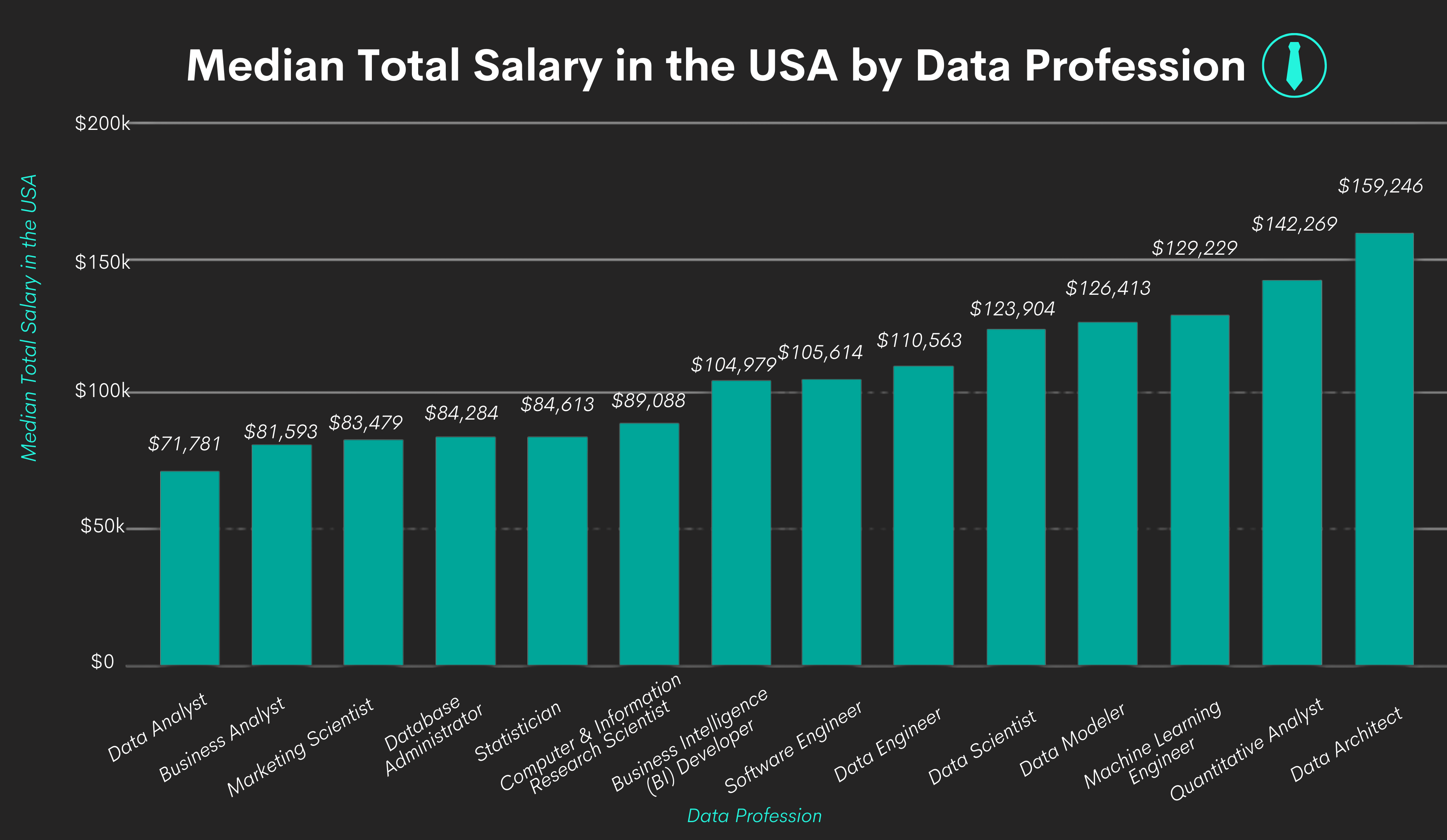
You can see that data analysts on average have the lowest salary. Data Architect, Quantitative Analyst, and ML Engineer are the highest-paid jobs.
One of the reasons is that data analysis is sometimes considered an entry position in the data science family of jobs. So data analysts are often people with no or little previous experience in data analysis.
That is not to say that there are no plenty of data analysts with years, even decades of experience, and job ads that require very experienced data analysis professionals. The thing is, many people want to learn different skills outside the data analysis, so they get interested more in, say, statistics, machine learning, data modeling, or data science, and then they move in this direction. The motivation for that could be that these are also generally higher-paying jobs.
We have an article for you in case you’re wondering How Much Do Data Scientist Make.
Data Analyst Salaries by Experience
The below chart shows data analyst salary by years of experience.

The chart shows there’s almost a steady increase of around $5,000 every two years between 0 and 9 years experience.
Then the salary increases more significantly and leads to the median total salary of $98,493 for data analysts with 15 or more years of experience. According to Glassdoor, the data analyst salary range for the most experienced can go up to $153k.
Data Analyst Salaries by Industries
The breakdown of data analyst salaries by top-paying industries is given below.
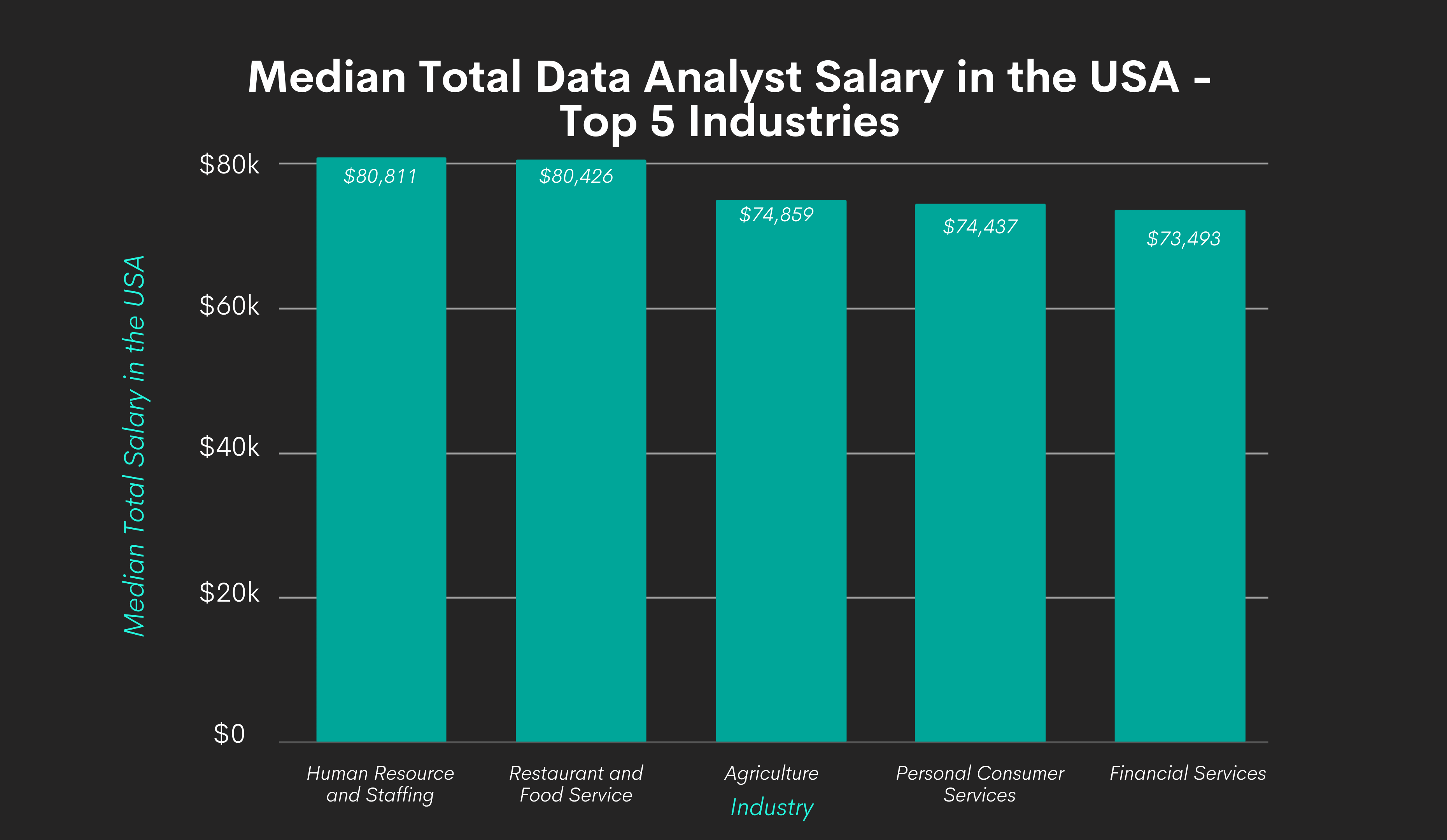
The highest-paying industry for a data analyst is Human Resources & Staffing with $80,811 median salary. Insignificantly lower pay is in Restaurants & Food Service. The other three highest-paying industries, with salaries little above or below $74,000, are Agriculture; Personal Consumer Services; Financial Services.
Here are the five lowest-paying industries.
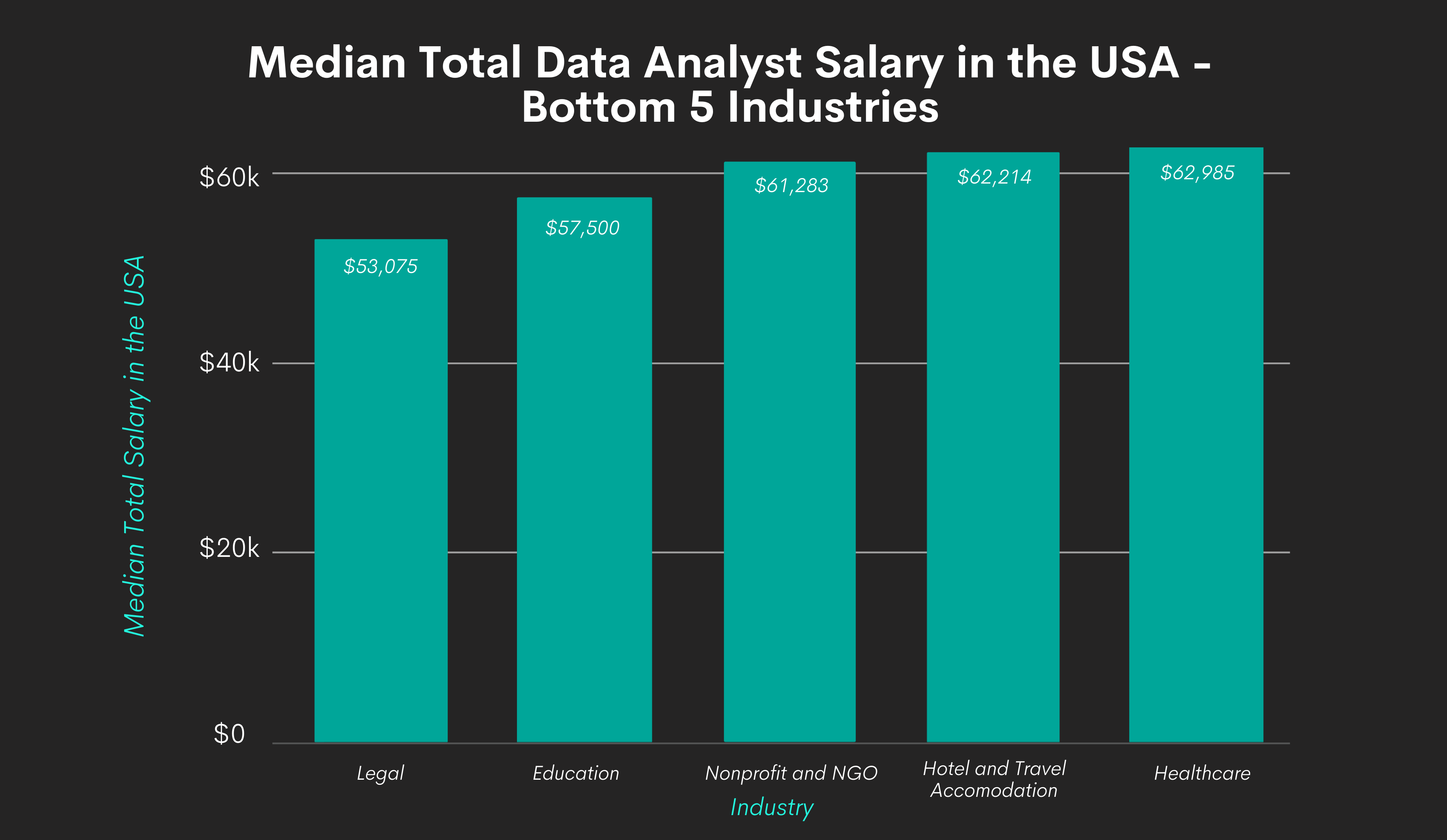
The lowest-paying industries are Legal; Education, with both industries paying below $60,000. Then come Nonprofit & NGO; Hotels & Travel Accommodation. The highest-paying is Healthcare with $62,985.
This was the median data analyst salary. Now, let’s have a look at the salary range by industry. These are the top-paying industries from the previous chart.

The industries in the above chart are sorted the same according to the median salaries in ascending order. It’s not surprising that the higher median generally leads to a higher salary upper end. However, there are some exceptions.
Even though Restaurants & Food Services have the second median salary, the Q3 value and upper end are higher than in Human Resources & Staffing. Agriculture has the lowest Q3 and upper end, despite its median being higher than Personal Consumer Services; Financial Services.
Let’s take a look at the lowest-paying industries.
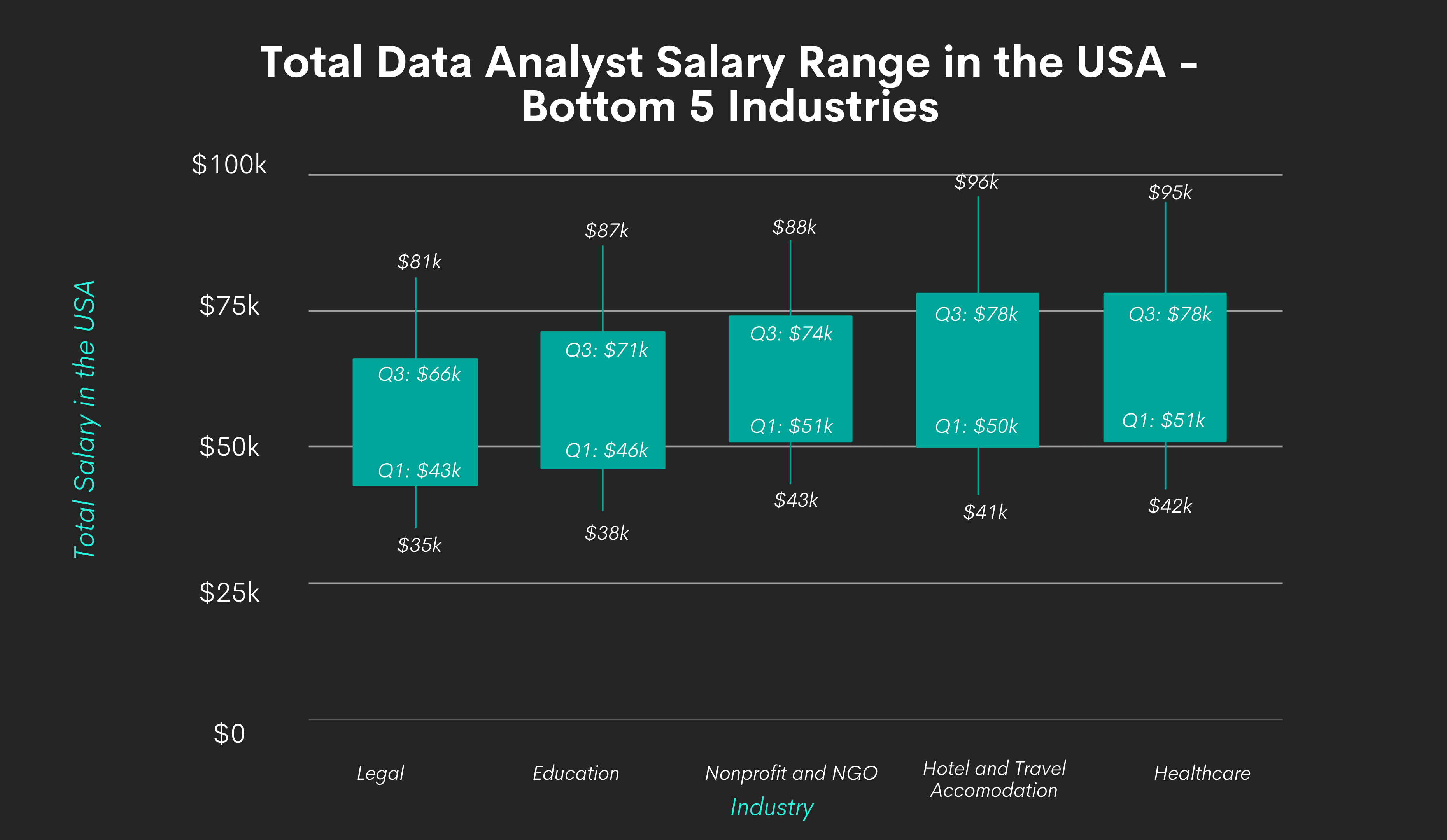
Legal’s all values are, unsurprisingly, the lowest of the lowest. Healthcare, even though it’s highest paying, has the upper end lower and Q3 the same as Hotels & Travel Accommodation.
Data Analyst Salaries by Location
We’ll take a look at two geographical segmentations. One is by USA state, and the other is by city, showing salaries in the ten most populous cities in the USA.
Data Analyst Salaries by USA State
Where you work is also one of the factors that could significantly influence your potential salary as a data analyst. Take a look at the median salaries by state.
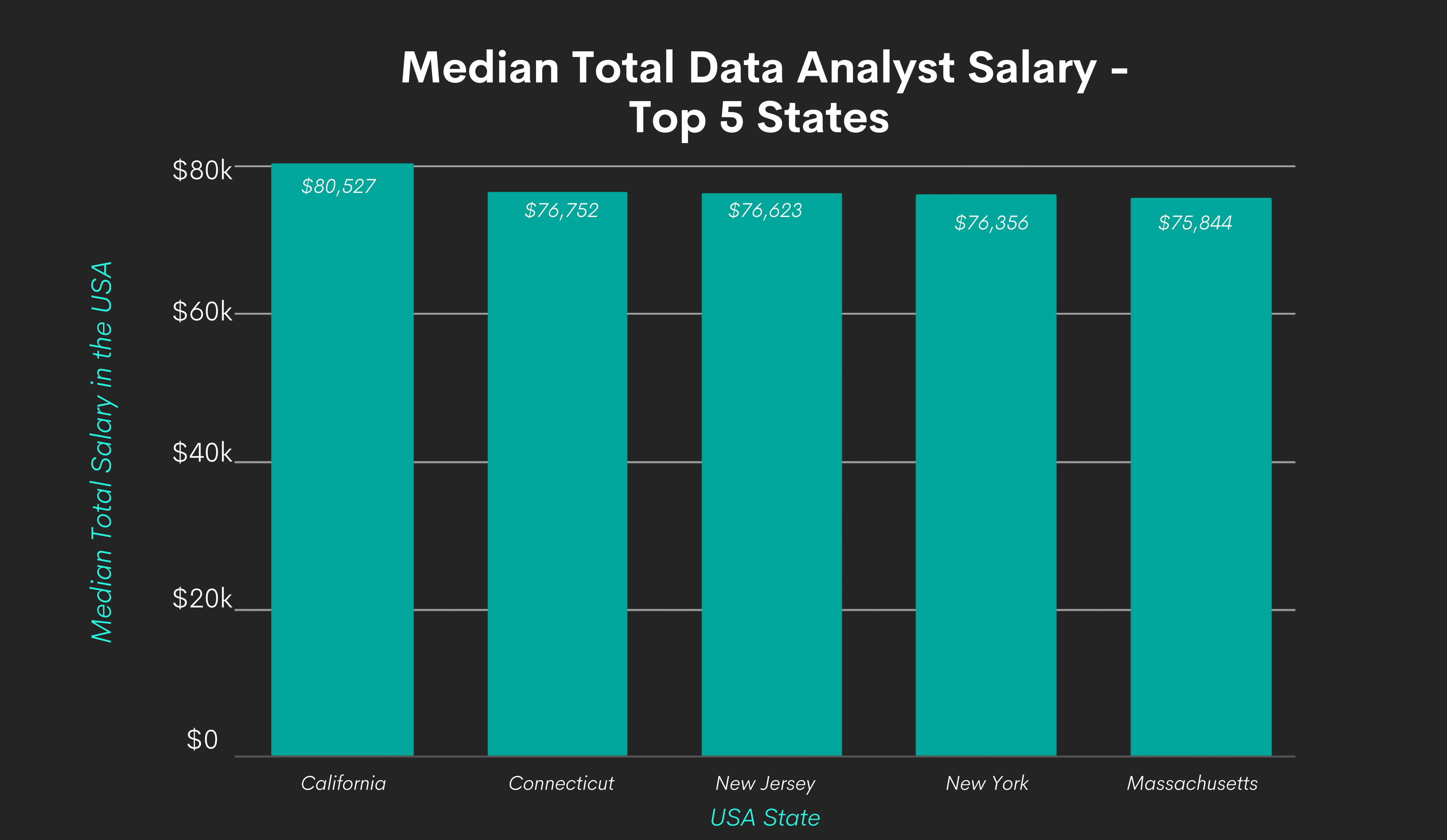
The highest median salary is in California at $80,527. With all those companies in Silicon Valley, it’s not surprising at all. Next come Connecticut, New Jersey, New York, and Massachusetts. They all have similar salaries and trail California by a couple of thousand dollars.
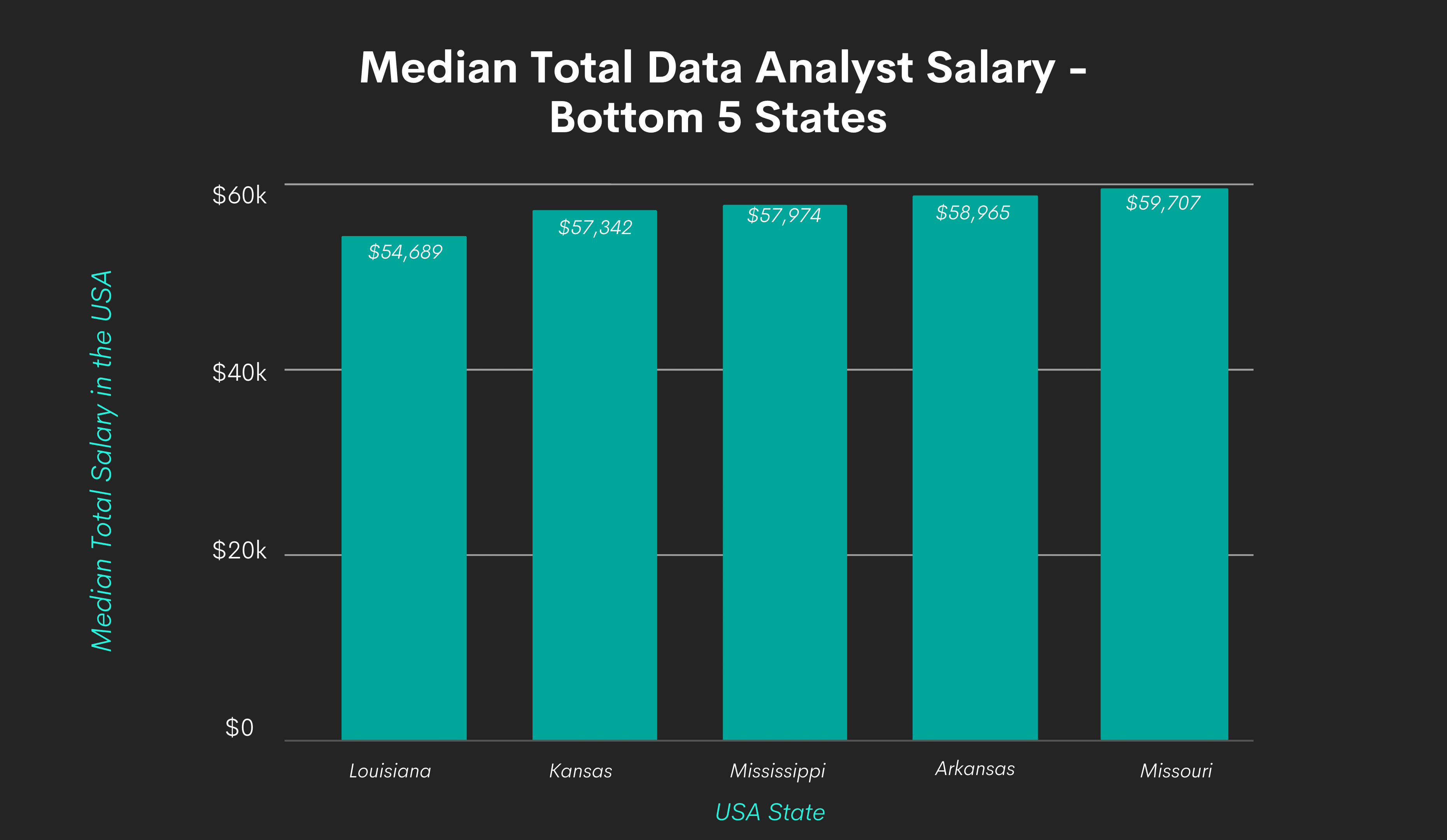
The lowest paying state is Louisiana, with a median salary of $54,689. Kansas and Mississippi come second and third from the bottom, respectively. Then comes Arkansas, and the closest to $60,000 is Missouri.
You now know where the money is. But it’s not the same where you work within a state. Each state has its own business center(s), so it’s not the same where you go if you’re considering becoming a data analyst and relocating to capitalize on that fully.
Data Analyst Salaries by City
People are where the work is. Bigger cities usually mean more (business) opportunities; money is usually also better. Let’s take a look at data analyst salaries in the top ten US cities by population.

The highest salary for data analysts is in New York City – $79,025. Then come Chicago and – somewhat surprisingly, since Pennsylvania is only the 22nd highest-paying state – Philadelphia. A notch higher than Los Angeles.
The lowest median salary is in San Diego.
Now, you wouldn’t be some of an analyst if you didn’t think the more expensive city is the salaries are higher.
Let’s see which of the most populous cities has the worst and the best rent vs. ratio. We’re comparing data from the above graph with the median rent for the one-bedroom apartment. The cities are again sorted from the highest to the lowest salary, like in the previous chart.
The cities are sorted from the highest median salary to the lowest from left to right.

New York City pays the best, but you won’t see most of this money since around 60% will go towards apartment rent. Chicago and Philadelphia are cities with the second and third highest salaries, but they have significantly better percentages of 28% and 23%, respectively.The best ratio is in San Antonio, Texas.
San Jose and San Diego, cities with the lowest median salary, are also among the worst regarding rent vs. percentage. The percentages are 45% and 46%, respectively, but it’s still significantly better than in New York.
Data Analyst Salaries at FAANG Companies
FAANG stands for Facebook (now Meta), Amazon, Apple, Netflix, and Google. These five are the members of Big Tech, the five largest tech companies in the USA.
They are at the forefront of technical advancement, data impersonated, and always looking for many data professionals, including data analysts.
Here’s the overview of salaries at FAANG.
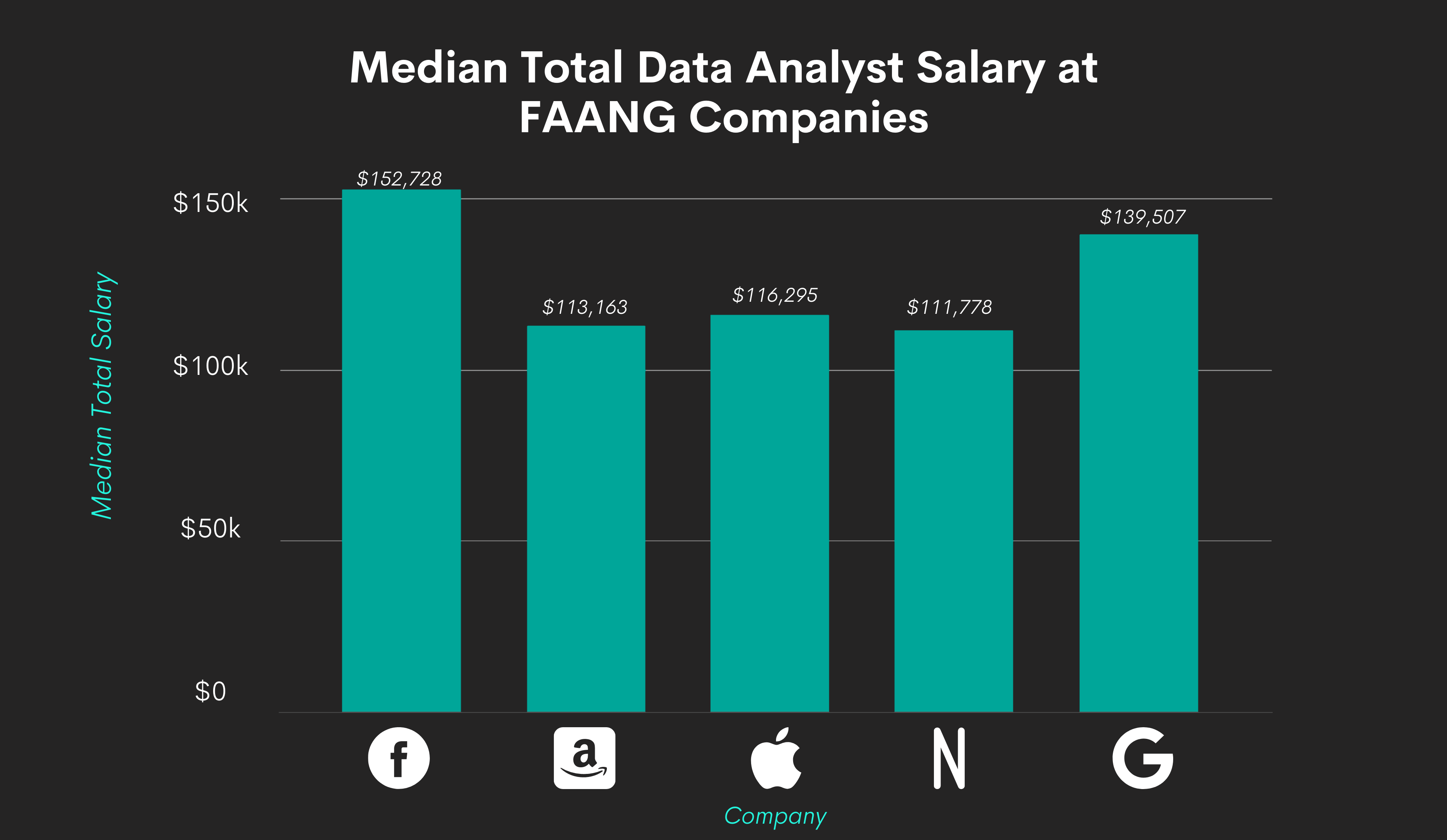
The highest paying company is Meta with $152,728. This is more than double the national median data analyst salary.
Google comes second with a $139,507 median salary. If you’re interested in more details, there’s an article about Google Data Scientist Salary.
The Other three companies are very close, with salaries between ca. $113K and $116K. Even those “low” amounts are still around 58% higher than the national data analyst median.
Data Analyst Salaries at Top 10 Paying Companies in the USA
You would think these five companies are also among the highest paying companies. Let’s check this by taking a look at the below chart showing the ten highest-paying companies for data analysts.
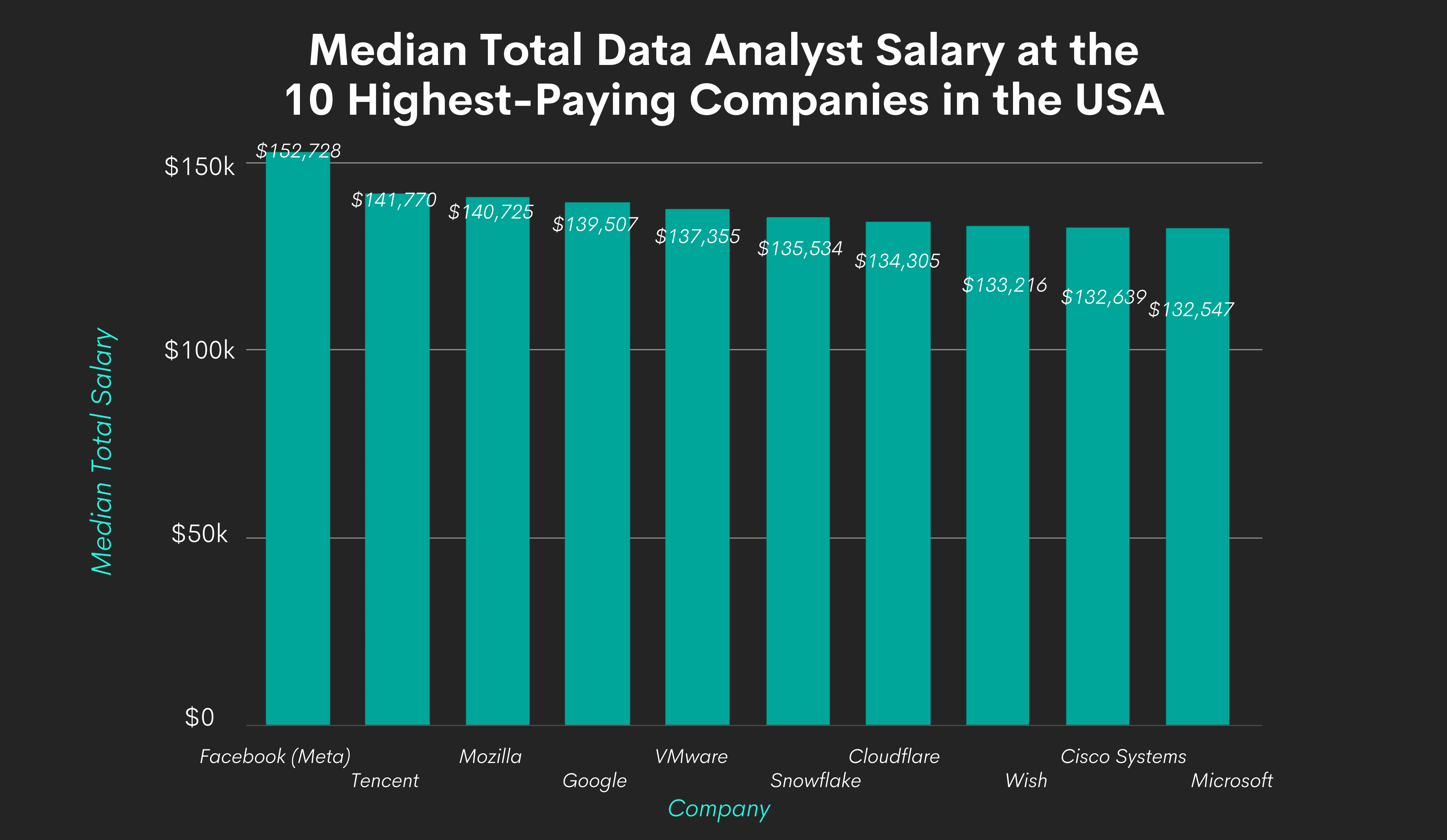
Nope, only two FAANG companies are amongst the top paying companies in the US – Facebook (Meta) and Google.
Truth be told, Meta tops the list here again. The second highest ranking is Tencent, while the third one is Mozilla.
The lowest paying is Microsoft, with $132,547. This “low” amount is still 85% higher than the US median for data analyst and 145% more (almost 1.5 times!) than the overall national salary median.
Summary
We imagined this detailed guide serving you as a reference point for data analyst salaries.
With this being our focal point, we showed you what you could earn on average. Also, we compared data analyst salary to other data professionals. You also learned how experience and your location influence the salary.
We also gave you an overview of salaries at FAANG companies and the top ten companies with the highest salaries. Nope, they’re not the same!
While salary is important, you should also consider other factors when becoming a data analyst. Those are knowing what data analyst does and what skills employers will be looking for. If you don’t have those skills, you’ll have to get them, and this article lists several solutions.
Equipped with all this knowledge, it’s time to decide – to be a data analyst or not to be.
Share


